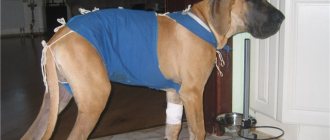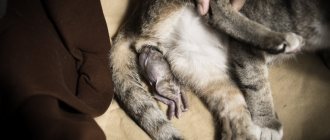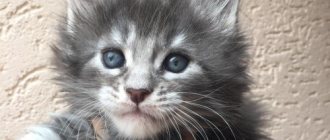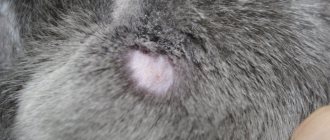Medical bandage for pet
To close a wound on the body of a domestic cat, ordinary bandaging is not enough. Feeling pain, the animal pulls off the bandage and chews out the surgical threads, risking infection in the suture. Therefore, veterinarians advise putting a sterile blanket on your pet. It is a blanket with holes for the paws and is tied at the back with ribbons. The device covers the lower part of the cat's body from the neck to the tail.
The main property of the product is to prevent pathogenic microflora from entering the surgical incision . Additionally protects the surface of the wound from sunlight and mechanical damage. When treating a sore spot with medications, the coverlet is partially untied without completely removing it.
Other uses:
- protection of the animal in the treatment of purulent ulcers and eczema;
- fixation of drainage;
- ensuring safety during treatment with acaricides;
- isolation of the tumor in the chest area;
- preventing contamination of animal care items.
The cost of a regular sanitary dressing is quite affordable. In November 2021 it was 75–120 rubles. This is a simple model with ribbons. If desired, the owner can purchase another version of factory tailoring with a pattern and fasteners with buttons, but in this case the price of the product will be from 1,700 rubles. a piece.
Product functions
The need for the cat to wear a special blanket or bandage during the postoperative period is determined by the doctor who performed the operation. Sometimes the specialist is able to place stitches in such a way that the cat does not need additional support. Therefore, wearing a bandage is not prescribed.
In most cases, the presence of a blanket is necessary, since additional protection of the operated area from dirt and pathogens is required. Contact of any contaminants or pathogens on unhealed wounds can cause an inflammatory process, which can lead to various complications. The blanket will close the seams from the external environment, thereby promoting faster healing of wounds.
This bandage prevents the pet from licking the operated area. The tongue of these furry animals is very rough. Therefore, he is able to damage the stitches, opening the wound. Cat saliva is considered a natural antiseptic. But it contains a large number of bacteria, some of which can cause inflammation. The blanket is an excellent protection against these two risk factors.
Wearing also limits the animal's mobility, thereby minimizing the possibility of seams coming apart due to the cat's activity. During the postoperative period, ichor or blood may leak from a still fresh suture. Such discharge not only stains your pet's fur, but can also remain on furniture or clothing. In the summer, such secretions attract blood-sucking insects that can carry pathogens. Wearing a special bandage helps prevent contamination of fur and objects, as well as protect wounds from contact with insects.
A homemade or purchased blanket is excellent protection for sutures, and also makes caring for a pet who has undergone surgery much easier. Only in rare cases, when a doctor uses a special suturing technique, will wearing a bandage be undesirable.
Something else interesting: How to make a comfortable cat house with your own hands
What types of blankets are there for cats?
There are several types of protective clothing for pets. The products differ from each other in material and cut features. Each option has its own purpose.
Warm
During the cold season, hairless cat breeds get cold and run the risk of catching a cold. Caring owners of Sphynxes and Cornish Rex dogs dress their pets in warm sleeveless vests. Soft fabric with a small pile perfectly protects from the wind and warms the animal during a walk. Even better are knitted wool blankets that fit the body. This product replaces the mustachioed friend’s own fur.
For hairless cat breeds, a warm blanket is an indispensable wardrobe item.
Homemade
Among furry pets, there are also those who suffer from allergic shedding. The owners have to constantly vacuum the furniture and often comb out the animals, although this does not save the situation. But you shouldn’t envy owners of “hairless” cats. Unfortunately, they have another physiological feature - increased sweating. There are stains on sofas and armchairs that are difficult to remove. Therefore, pets are dressed in blankets made of light cotton fabric, reminiscent of a robe or T-shirt. Such clothing absorbs skin secretions well and limits hair loss.
A satin blanket will protect furniture from your pet's sweating
Most home capes still belong to wardrobe items. However, some models are necessary for the daily care of animals with incurable diseases.
When veterinarians discovered a tumor on an elderly cat's mammary gland, the owners were forced to make difficult choices. They did not agree to the operation, which still would not bring recovery. The pet constantly reached out to the sore spot and licked it. Redness and inflammation began. Then the owners put a loose blanket on the cat. It is surprising that the animal quickly got used to the “cover” and only slightly protested at first. The tumor, covered with tissue, became less inflamed by the actions of the furry pet. The use of a protective device thus made it possible to extend the earthly existence of a doomed living creature for another year and a half.
Fastening a blanket with a zipper is much more convenient than tying ribbons
Raincoats
When walking with your pet outside in cloudy weather, do not forget to take a rain cape for your pet. The model has a hood and fastens under the neck and belly. The product is sewn from waterproof material - nylon or vinyl chloride. Polyamide fiber of bright color is not inferior in properties to transparent film. In the event of an unexpected downpour, only the animal's paws will get wet in such a raincoat.
Postoperative blankets
It's hard to say when veterinarians came up with the idea of covering surgical stitches on pets with a large bandage that attaches to the back. Since the sixties of the last century, only an Elizabethan collar was used to isolate the wound from the animal’s reach. The cone attached to the cat's neck caused significant inconvenience. Not only could the pupil not wash her face, she found it difficult to drink and eat. The owner watched with pity as the funnel knocked on the cup of food, but the food did not fall into the mouth. We had to temporarily remove the device and risk the health of our mustachioed pet. Moving around the rooms threatened with injury: the edges of the cone clung to furniture and door frames.
It is not surprising that the blanket has become an excellent replacement for a neck device after abdominal surgery. It's nice to see that your pet feels freer and can even play. Although the protective mantle with ribbons still restricts movement, it does not prevent the cat from eating and caring for itself normally. Therefore, the animal’s recovery occurs faster.
And now in some European countries veterinarians only use a collar. As an alternative, they recommend that owners put homemade sleeveless vests on their animals, made from baby overalls for infants.
Interestingly, in Russia, Sergei and Angelina Kovalev received a patent for the invention of a postoperative blanket for domestic cats in 2002. Their product is conveniently fastened with Velcro located above the neck and spine of the animal.
Instructions for putting on
most often the blanket is put on the cat right in the veterinary clinic
Most often, the blanket is fixed to the cat’s body using ties, but there are also options on sale with Velcro and zippers. It is easier to dress an animal in a bandage with Velcro or a zipper, but such products are usually much more expensive.
As you already know, most often a blanket is put on a cat right in the veterinary clinic; in most cases, at this time the animal is still under anesthesia or only partially conscious. In this state, the purr offers no resistance, which greatly simplifies the task. If difficulties arise, seek help from the veterinary clinic staff. Now the main thing for you is not to make sudden movements when manipulating the animal’s body, be extremely careful - fresh stitches are very easy to damage!
Subsequent times, when removing and putting on the bandage to treat the wound, you will have to deal with an active animal. It is important to act as calmly as possible. If your pet is noticeably nervous, try to calm him down with petting and a gentle voice.
Choosing a sanitary dressing
You need to take care of protective equipment for your pet in advance, even before the scheduled operation. Then your pet will quickly get used to the medical gown, and wearing it after sterilization will not aggravate the stressful condition. Prepare at least two hygiene items to replace it after it gets dirty. When purchasing a product, pay attention to its appearance and fabric composition.
Material
Medical blankets in pharmacies at veterinary hospitals are usually made of non-woven fabric. This base does not contain lint and does not crumble if you need to trim the product to make it more comfortable for the animal. The pressed fibers perfectly absorb liquid, keeping the surface of the wound dry. Another advantage of such a base is its resistance to tearing by claws, as well as a long service life. The product can withstand repeated washing and does not affect your pet's skin.
Factory blankets are sewn from different fabrics:
- cotton;
- viscose;
- spunbond;
- meltblown.
To ensure free access of air to the wound, material made from natural threads is preferable. Foreign manufacturers often use a cotton-lycra blend to give the product stretch. In this case, the fabric limits freedom of movement less.
Size
Before purchasing a product, you need to weigh the animal, and also determine the circumference of the chest (behind the front legs). The length of a large bandage will be 7 cm longer. If the bandage is chosen correctly, then the width of the open part of the pet’s back is no more than 8–9 cm . The volume of the product is easy to adjust with ties, but the size remains unchanged.
Factories usually sew post-operative blankets for adult cats weighing 3–5 kg. Finding a protective device for a kitten is more difficult. For him, the size of the product along the length of the body from the base of the neck to the beginning of the tail will be 28 cm, and the model range starts from 38 cm with a chest circumference of 31 cm. Large animals with a body weight of 6–10 kg will be suitable for a protective bandage with dimensions of 42x35 cm.
Model type
There are several types of medical blankets for cats. They differ in the processing of the holes for the paws and the way the bandage is secured to the animal. A one-piece product with slits is less common than a coverlet that covers the limbs. The sleeveless robe is trimmed with a durable piping that covers all the edges and prevents the fabric from fraying.
A blanket with cutouts for cat paws is used in the treatment of back wounds
Most post-surgical blankets are secured to the pet's back with 6-7 pairs of ribbons. Bandages with Velcro fastening are much easier to use . The wide apron can be easily removed if necessary. On an individual order, the tailor can improve the fastening by replacing part of the ties with a zipper braid.
There are also expensive models with push-button clasps on sale. They are located on both sides near the animal's neck. Dutch manufacturers have equipped the hygiene product with an internal pocket. A bandage with medicine is placed there.
Rules for tying on an animal
scheme for attaching a blanket to a cat
Let's focus on how you can put a blanket on a cat. First, make sure that the bandage is positioned correctly on the table, the reference points are symmetrical cutouts for the front legs. The cat's head should be slightly in front of them, and the cutouts themselves should be in the area of your pet's front armpits.
A standard blanket has 7 pairs of laces for fixation, symmetrically located along the side edges of the product. They have to be tied on the back of the animal. Considering that you will often have to remove and put on the bandage, you should not make the knots too tight. However, too weak a fixation can create problems: the cat will be able to untie the laces with its teeth and get rid of the bandage.
- You need to tie the blanket correctly starting from the head. Taking the two laces at the front, fix them on the purr's neck.
- The next two pairs of ribbons need to be tied crosswise on the animal’s shoulder blades, that is, the right tie from the third pair is connected to the left tie from the second pair, the right tie from the second pair is connected to the left tie from the third pair. So you should get a crosshair made of ribbons on your pet’s withers.
- The following laces are tied in pairs on the back.
- The last two pairs of ties should be secured crosswise on the back of the animal's body.
When fixing the blanket, do not squeeze the animal’s body too much. If you notice that the cat's movements have become constrained, slightly loosen the lacing. Also make sure that the bandage does not cover the animal’s excretory openings: the anus and urinary tract. Otherwise, due to discomfort, the animal will try to remove the post-operative bandage, and you will be faced with the fact that the blanket will very soon be dirty.
If the wound on your pet’s body is small, it is not necessary to completely remove the blanket to treat it - free only that part of the body where the surgical suture is located, this way you will save your time and your pet’s nerves in the process of fixing the bandage. When tying ribbons, do not leave long ends. Remember that your cat can easily pull them with his teeth, loosening or untying the knot.
It is allowed to remove the bandage for 15-20 minutes 2-3 times a day, especially if the cat does not get used to it well. However, at this time the pet should be under your close attention. When trying to lick stitches and wounds, you must immediately gently prevent this: caress the animal or distract it with food.
It's best to have another blanket just in case. You should not rule out the possibility that your pet may tear the bandage with its teeth or get it very dirty, in which case it will be necessary to replace the bandage.
How to make a blanket with your own hands
If you decide to sew a post-operative bandage for an adult cat yourself, then it is better to use your own knitted items for this. The animal knows the smell of the owner and wearing such a product will cause less protest than with a factory bandage. The summer dress your daughter has outgrown is also suitable for sewing a large headband.
Tools and materials
To make a protective blanket, use chintz or printed calico, which are sufficiently breathable and at the same time soft and dense. It is advisable that the new fabric be washed in advance, otherwise it will shrink during use. The blanket is sewn from two layers of light-colored material.
We will need:
- pins;
- pencil;
- ruler;
- scissors;
- threads;
- needle;
- textile;
- tapes.
To take measurements from your furry pet, use a tailor's centimeter. It is also suitable for marking blankets if the length of the ruler is shorter than 40 cm.
Manufacturing stages
Lay out all the parts to work on the table. The model will have 14 ribbons, so you will have to use 3.5 meters of ribbon. It can be replaced with strips of any durable textile or synthetic material.
Cutting the required amount of fabric
Together with an assistant, measure the cat and write down the obtained values. Usually the animal takes your actions as the start of the game, so it will be difficult to cope alone.
Main parameters:
- body length from the neck to the beginning of the tail;
- chest girth;
- abdominal circumference;
- distance between all four paws.
The piece of fabric for cutting has the shape of a rectangle. The dimensions of one piece are 38x32 cm with an allowance of 0.5 cm.
Manufacturing process:
- The fabric is folded in half with the wrong side out.
- Fasten with pins so that it does not move.
- From the top edge of the front part, put 5 cm to the fold, mark with a pencil. There remains 10.5 cm to cover the animal's neck.
- Draw cutouts for the front paws 12 cm deep and 6 cm wide. Their shape resembles an oval.
- The length of the fixing bandage over the cat's spine is approximately 16 cm. The size under the belly is 38 cm. At the tail between the hind legs, half the width along the edge will be 4.5 cm. The value is measured from the fold upward, a notch is placed, then 10 cm is set aside along the outer edge of the fabric.
- The resulting angle is rounded inside with a pencil.
- Place marks on all places where the tapes are attached.
- Using scissors, cut out the contours of the product.
- Take out the pins.
- You get two blanks for a postoperative blanket.
Sewing on ribbons to secure the bandage on the pet
Each 25 cm long ribbon is stitched from one edge so that the threads do not spill out. Then all 14 pieces are placed with the other end on the wrong side of one part of the blanket, sewn by hand or using a machine zigzag stitch. Check that the ties are held tightly. They try on and remove excess tissue if necessary.
Edge processing
To ensure that the device is of good quality and safe for caring for your pet, all open areas of the material are carefully closed and stitched. If even one small thread gets into the wound, it will immediately begin to rot. Inflammation of the surgical suture is the most common postoperative complication . This is why quality processing of tissue sections is so important.
There are several ways to insulate the edge of a product. The simplest one: on both parts of the blanket, fold the edges inward and sew by hand along the right side of the fabric. Make two parallel lines at a distance of 3 mm from one another. You can cover the sections with edging made of fabric in a contrasting color. The third option is the most time-consuming. Place the two parts of the blanket together, face inward, and pin the attached ties to the center of the product. Stitch both pieces together, leaving no seams for the ribbons. Turn it inside out, remove the pins, and pull the ribbons up with the free ends. After this, sew the outer stitch. This results in a strong connection with closed edges.
We sew the blanket ourselves
In this case, light natural cotton fabrics are suitable. This material allows air to pass through well and is quite durable. A light color will always indicate the presence of dirt.
Next you need to make a pattern on paper and transfer it to fabric. It will be easier to use the pattern layout and change the measurements to your own. Leave a margin of 1 cm for the space between the edges for stitching.
It is advisable to make a double bandage for the cat after surgery. To do this, fold the fabric with the wrong side facing out. During the stitching process, leave a small section through which you will then turn the product inside out and stitch it.
If you cannot finish the edges, you can fold them twice. Make sure that the fabric does not fray and the threads do not stick out. If a thread gets into a seam, it can cause suppuration. You can take the braid, trim the edges with it and leave some extra for the ties.
Next, we sew on the ties, or better yet, stitch them together. Take plenty of material, durable and wide, so it won’t put pressure on your pet. A cat blanket should fit perfectly to the body. We recommend making a replacement version immediately.
The main advantage of such a postoperative bandage for cats is reliability, because it is sewn to individual measurements.
Using the fixture
The doctor puts a bandage on the cat immediately after sterilization, while the animal is under anesthesia. Before tying a protective blanket, press a sterile napkin soaked in an antiseptic to the wound. The blanket not only covers the damaged area of the skin, but also limits the animal’s movements. This is necessary so that the active scratch does not jump, otherwise the seams will come apart. The surgical incision is inspected and processed every other day, untying some of the tapes on the back and at the hind leg. If liquid appears on the surface of the fabric, the bandage is changed immediately.
After the surgeon removes the suture threads, the blanket is put back on the pet to protect the surface of the wound. But now the sanitary bandage is worn for 3–5 days. If the healing of the skin area is complete, the safety gown is finally removed.
How to fix it correctly
A blanket is laid out on the table and a cat is placed on top. If your mustachioed beast is impatient, ask another person to gently hold her. Talk kindly and calm the animal. Ribbons of the first pair (at the neck) are tied together above the withers, and numbers 2 and 3 are crossed above the beginning of the back and secured in one knot. The ribbons at the hind legs are connected on opposite sides: the sixth on the right and the seventh on the left. Tied together. The remaining two pairs of ribbons (4 and 5) are tied on the cat’s back. Veterinarians recommend making the ends of 7, 6 and 5 rows of ribbons in one knot to reduce the inconvenience of wearing a blanket for the animal.
The blanket should not be tied too tightly to prevent swelling of the pet’s skin.
The bandage should not be tight or too loose. It is considered optimal if a finger fits freely under the bandage. When an animal cannot walk in a blanket and falls, the fastening above the ridge is too rigid and should be loosened. Make sure that the cat does not accidentally damage the ribbons.
How long can you wear it without taking it off?
If the wound is dry, there is no swelling or redness, then after 8–10 days the bandage is removed. But at the same time, the cat cannot be left alone. Watch how she behaves. If he begins to intensively lick the wound or injure the sore area, then he will have to put on the blanket again and show the animal to the doctor. The cause of restless behavior is probably hidden inflammation.
Video: a cat walks around the house with a large bandage tied on its back
Features of using the bandage
For a cat, an oval cutout is made on the belly under the tail using a purchased or homemade blanket. Otherwise, you will have to untie some of the ribbons from the back and turn back the edge so that the animal can go to the toilet. This is inconvenient for both the owner and the sick pet.
Our mustachioed friends have different views on being forced to wear a blanket. Some show hatred with their entire appearance and persistently try to remove it by biting the ribbons with their teeth. Others are cunning and pretend that the protective bandage does not bother them at all. The reason for this behavior is simple - the cat is patiently waiting for the ribbons on its neck to loosen. And one morning you find your pet without a bandage, which was left lying somewhere in the corner of the room. It turns out that the cat has already pulled out all the threads from the wound. It is good if the suture is almost healed, i.e. there is no bleeding or fluid discharge. In some cases, you have to take your unruly pet to the surgeon again. Then the treatment is delayed for months, and a scar remains at the site of the incision.
When and who needs a blanket
Most cats try to lick the stitches after surgery, which leads to many negative consequences. Therefore, if the cut is accessible, it needs to be secured. Classic sterilization is carried out along the white line, with the seam located in the very center of the abdomen. If the operation is performed laparoscopically, the blanket can be abandoned.
In addition, clothing is needed for all abdominal operations, as well as for operations on the mammary glands. Can be used for hygienic purposes and also as insulation.
When is it possible to remove the protective device early?
The protective bandage is made from natural fabrics (cotton) and does not irritate the animal’s skin
. Early removal is possible if:
- the surgical intervention was carried out using laparoscopy: in this case, the wound is so small that protection is not required;
- when performing sterilization, the surgeon used absorbable suture material and protective sprays to treat the wound;
- Four days after the operation, the cat has a normal body temperature, there is no bleeding, redness of the suture, or suppuration.
Important! When using suture material that requires further removal, you should not remove the bandage ahead of time, even if it causes discomfort to the animal.
After examining your pet, the doctor may recommend getting rid of the protective accessory ahead of schedule if:
- aggression is clearly expressed, the animal continuously tears off and gnaws the blanket;
- the animal is afraid to walk in a bandage;
- ulcerations appeared under the places where the tissue puts maximum pressure on the body;
- the bandage became very dirty due to eating and visiting the toilet.
Why does a cat need a post-operative bandage?
The most popular use of a post-operative bandage is to protect a cat's suture after sterilization. However, there are other equally important functions:
- Protecting the seam from dust and wool and thereby preventing the inflammatory process.
- Limits the pet's flexibility, thereby reducing the risk of the seam coming apart when licking the groin area and hind legs.
- Preventing various blood-sucking parasites from entering the wound. Special antiseptic wipes are placed under the blanket, which absorb the ichor and prevent the smell of blood from spreading.
Important! The use of a cat bandage is not necessary after sterilization. There are types of sutures over which it is not necessary to wear a special tightening bandage. The cat may also lack the instinct to lick a wound.











